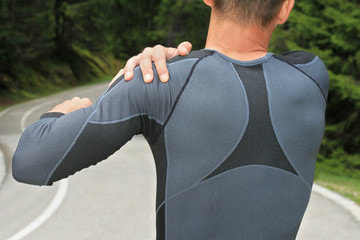|
By Dr. Jessica Warnecke, PT, DPT, OCS  As April rolls around, Spring sports are already in full swing. A common area of the body in which many baseball, tennis, softball, and other spring athletes deal with injury is the shoulder. Whether it be a simple, yet nagging, injury such as impingement or a more serious condition such as a rotator cuff tear, physical therapy provides important stretching and strengthening rehabilitation exercises to help eradicate pain and prevent future problems. Impingement syndrome, also known as swimmer’s shoulder, presents itself as sharp, aching, or dull pain to the shoulder area. It is commonly caused by repetitive shoulder activities that lead to inflammation; however, injury, muscle tightness, poor posture, and other factors can also lead to shoulder impingement. Increased pain with lifting or reaching movements, decreased range of motion, and weakness are the major symptoms that are present with this condition. There are a number of muscle deficits that come with shoulder impingement. Our lower trapezius is the lowest section of the large trapezoid muscle which extends from the occipital bone of our skull down to the spinous process of T12 and out to the acromion process at our shoulders. It plays a vital role in our dynamic shoulder stability. The fibers of the lower traps help assist our shoulder with upward rotation and contribute to scapular retraction. If the lower traps are weak, they can’t counter-balance the work from our rhomboids and levator scapulae during movement, leading to shoulder imbalances and impingement pain. In addition to the lower traps, the serratus anterior plays an important role in the dynamic control of our shoulder blades every time we raise our arms up or down. It runs from the first eight ribs to the middle border of the scapula and also helps with protraction (moving the shoulder blade forward on your thoracic spine). Weakness in this muscle can lead to muscle imbalances, scapular winging, shoulder impingement, and many other injuries. By including dynamic closed kinetic chain training to your workout, you can help improve your neuromuscular communication--keeping this muscle strong, our shoulders stable, and providing the foundation for higher level sports and training performance. Like shoulder impingement, rotator cuff tears occur in people who perform the same shoulder motions repeatedly such as a tennis player or baseball pitcher; however, it can just as easily affect us during regular daily tasks. Lifting a heavy grocery bag or suitcase, having poor posture, or reaching behind you for the backseat of your car can all lead to rotator cuff tears. The rotator cuff is a set of four muscles in your shoulder that come together as tendons to form a covering around the head of the humerus. It attaches the humerus to the shoulder blade and aids in lifting and rotation of your arm working with the deltoid to maintain stability. Now, it's not uncommon for many of us to have small tears in our RTC tendons. And often times, these tears aren't painful. But having a tear, muscle weakness, and poor body mechanics can all limit daily tasks such as combing your hair, reaching for a glass in the cupboard or putting on a jacket. It's also important to understand that just because you may have a rotator cuff tear, does NOT mean you need surgery to heal. Many grade 1 and 2 tears are successfully treated in PT to help get you back to unrestricted activity and prevent a 9+ month stint in post-surgery rehab. There are a number of different strengthening exercises that can be added to your workout to prevent these conditions altogether. By improving both the mobility and stability of your shoulders, you are preventing months of rehab time that come with injury. If you take the time to add a variety of dynamic variations along with your strengthening workout, you will activate your lower and middle traps, serratus anterior, and other “less focused on” shoulder muscles, which, in the end, will help improve scapular stability and prevent injuries such as impingement or rotator cuff tears.
Shoulder injuries can become very nagging if the root cause is not addressed. For active individuals, simple rest and activity avoidance won't be the end all fix. If you've been dealing with shoulder pain from a sport, new hobby, or intermittently over the past few years, I highly recommend prioritizing YOUR health, having a full assessment of the shoulder, and getting down to the source. Addressing pain and dysfunction early on prevents worsening issues in the future, unnecessary days of pain, and allows you to live your life in an optimal way!
1 Comment
10/20/2019 11:53:51 pm
Activities are good for the body and we can ensure the strength of our body if we know how to do the baby steps so that there will be no unwanted pain. This is an important part that we should not forget so that there will be no aches that will happen. The movements that we are about to do should be done properly and with supervision of adults.I know that we can never go wrong if we follow these rules. Rules are made for a purpose.
Reply
Your comment will be posted after it is approved.
Leave a Reply. |
Meet Your TherapistJessica has been in Austin, TX for the past four years. She grew up in Idaho and attended PT school at Idaho State University. She completed an Orthopaedic Residency and became a Board Certified Orthopaedic Clinical Specialist in 2016. Archives
February 2022
Categories
All
|

 RSS Feed
RSS Feed